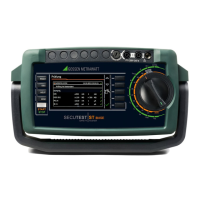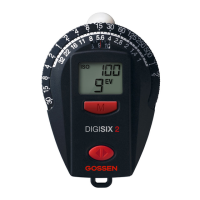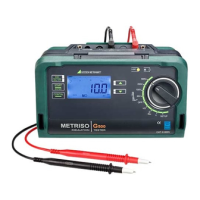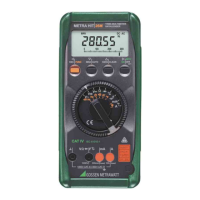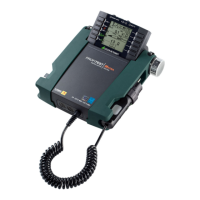GMC-I Messtechnik GmbH 5
15 Repair and Replacement Parts Service
Calibration Center and Rental Instrument
Service ............................................................................90
16 Product Support ............................................................. 90
1 Applications
1.1 Table: Types of DUTs – Tests – Standards
The test instrument may not be used for measurements
within electrical systems! The test instrument must be
operated within the same electrical system as the test
object!
Test sequences for VDE 0701-0702, ÖVE 8701 and
SNR 462638 are identical. In the interest of improved read-
ability, only VDE 0701-0702 is described below. The expla-
nations apply to ÖVE 8701 and SNR 462638 as well. The
instrument can be switched to the country-specific stan-
dard designation in SETUP (page 1/3) under “Auto Mea-
surements”, “Measuring Sequence Parameters”.
1.2 Table: Single Measurements – Regulations
Key
• Specified test
2 Safety Features and Precautions
SECUTEST BASE(10), SECUTEST PRO and SECULIFE ST BASE(25) test
instruments fulfill all requirements of applicable EU directives and
national regulations. We confirm this with the CE mark.
The relevant declaration of conformity can be obtained from
GMC-I Messtechnik GmbH.
The test instruments are manufactured and tested in accordance
with the following safety regulations: IEC 61010-1 / DIN EN
61010-1 / VDE 0411-1,
DIN EN 61557-16/VDE 0413-16
Safety of the operator, as well as that of the test instrument and
the device under test, is only assured when it’s used for its
intended purpose.
Read the operating instructions carefully and completely before placing your
test instrument into service. Follow all instructions contained therein. Make
sure that the operating instructions are available to all users of the instru-
ment.
Tests may only be performed by a qualified electrician, or under the
supervision and direction of a qualified electrician.The user must be
instructed by a qualified electrician concerning performance and evalua-
tion of the test.
Suitable personal safety equipment is required.
If you use active or passive body assistance, please consult your
physician or the manufacturer of the body assistance device.
Manufacturers and importers of medical electric devices must
provide documentation for the performance of maintenance by
trained personnel.
Observe the following safety precautions:
•
The instrument may only be connected to TN, TT or IT electrical
systems with a maximum of 240 V which comply with applicable
safety regulations (e.g. IEC 60346, VDE 0100) and are protected
with a fuse or circuit breaker with a maximum rating of 16 A.
• Measurements within electrical systems are prohibited.
•
Be prepared for the occurrence of unexpected voltages at
devices
under test
(for example, capacitors can be dangerously charged).
• Make certain that the measurement cables are in flawless condi-
tion, e.g. no damage to insulation, no cracks in cables or plugs
etc.
• When using a test probe with coil cord (SK2W):
Grip the tip of the test probe firmly, for example if it has been
inserted into a jack socket. Tensioning at the coil cord may
otherwise cause the test probe to snap back resulting in pos-
sible injury.
• Measurement of insulation resistance and equivalent leakage current
(alternative leakage current measuring method)
Testing is conducted with up to 500 V. Current limiting is uti-
lized (I < 3.5 mA), but if terminals L or N at the test socket or
the test probe are touched, electrical shock may occur which
could result in consequential accidents.
• Leakage current measurement while connected to line voltage
It’s absolutely essential to assure that the device under test is
operated with line voltage during performance of the leakage
current measurement. Exposed conductive parts may con-
duct dangerous touch voltage during testing, and may not
under any circumstances be touched.
(Mains power is discon-
nected if leakage current exceeds approx. 10 mA.)
The function test may only be performed after the DUT has
successfully passed the safety test!
Testing after Repairs /
Periodic Testing
Test DUTs
in accordance with
the following standards
EN 50678, draft
DIN VDE 0701-0702
IEC 62353
DIN EN 62353
(VDE 0751-1)
IEC 60974-4
DIN EN 60974-4
VDE 0544-4
Electric devices •
Work devices •
Mains operated electronic devices
•
Hand-held electric tools •
Extension cords •
Household appliances •
Data processing devices •
Medical electric
devices, applied parts
•
Welding units •
Single measurements
per Regulation
EN 50678, draft
DIN VDE 0701-0702
IEC 62353
DIN EN 62353
(VDE 0751-1)
IEC 60974-4
DIN EN 60974-4
VDE 0544-4
Protective conductor resistance •
••
Insulation resistance
•••
Protective conductor current
•
Primary leakage current
•
Device leakage current
•
Touch current
••
Current from welding circuits
•
Patient leakage current
•
Leakage current from the applied part
•
Test methods
Alternative measuring method (equivalent
(device) leakage current)
••
Differential current measuring method
•••
Direct measuring method
•••

